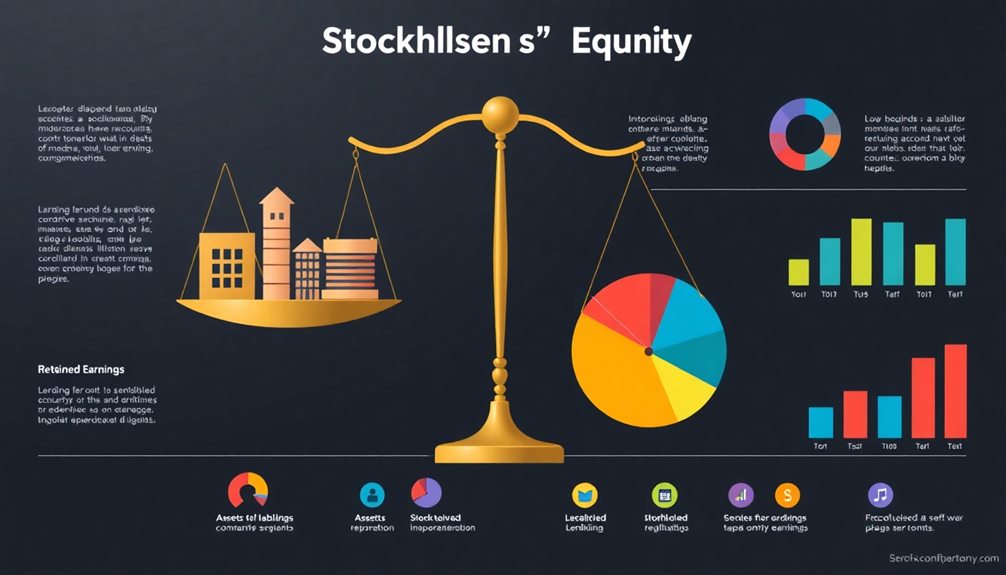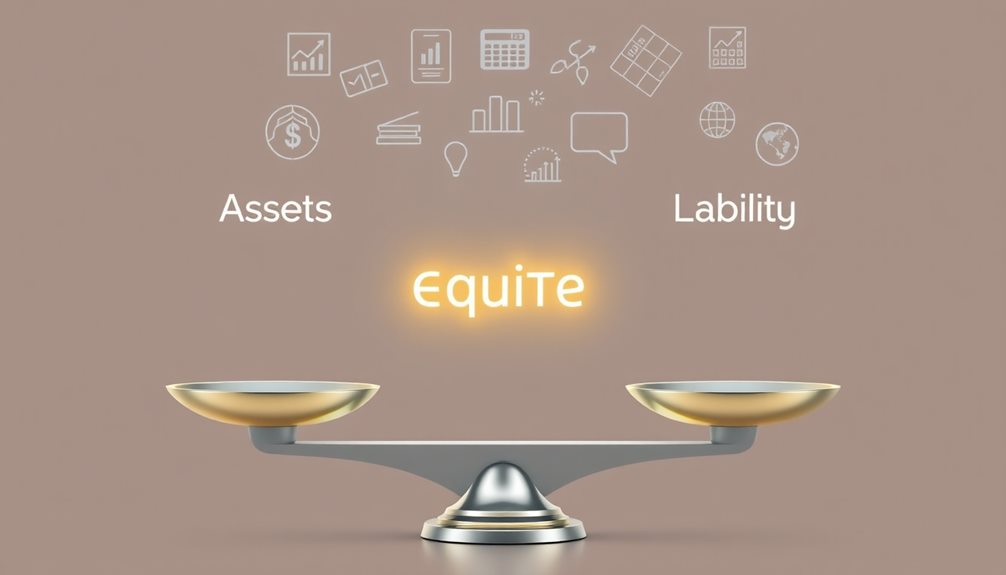The stockholders' equity formula is simple: it's total assets minus total liabilities. This calculation reveals the value left for shareholders after all obligations are met. Understanding this formula is crucial, as positive equity indicates financial stability, while negative equity can signal trouble. Key components include common stock, retained earnings, and additional paid-in capital. Don't forget about treasury shares, which reduce equity when repurchased. Knowing how to accurately calculate this can influence your investment decisions considerably. Explore further to uncover more insights about how equity impacts your financial evaluations and strategies.
Key Takeaways
- Stockholders' equity is calculated as Total Assets minus Total Liabilities, reflecting the company's net worth available to shareholders.
- Key components of equity include common stock, preferred stock, retained earnings, additional paid-in capital, and treasury stock.
- A strong equity position indicates financial stability and can enhance investor confidence in a company.
- Treasury shares are repurchased stocks that reduce total stockholders' equity and do not receive dividends or voting rights.
- Understanding stockholders' equity trends provides insights into a company's profitability, growth potential, and investment risks.
Understanding Stockholders' Equity

Understanding stockholders' equity is essential because it reveals the true value of your investment in a company. Stockholders' equity is calculated using the formula: Stockholders' Equity = Total Assets – Total Liabilities. This figure reflects your residual interest in a company's assets after settling all obligations.
The components of stockholders' equity include common stock, preferred stock, retained earnings, additional paid-in capital, and treasury stock. Among these, retained earnings often represent the largest portion, showcasing the cumulative profits that have been reinvested rather than distributed as dividends. This focus on retained earnings highlights a company's growth strategy and its commitment to financial health.
Positive equity indicates that a company has enough assets to cover its liabilities, which is a reassuring sign of stability. Conversely, negative equity may signal potential financial distress, raising concerns about insolvency risks.
Regularly analyzing stockholders' equity trends allows you to assess the company's financial position over time, providing insights into its growth and profitability. Understanding these dynamics helps you make informed investment decisions, ensuring you stay aligned with your financial goals.
Key Components of Equity

When you look at stockholders' equity, you'll notice that common stock and retained earnings play essential roles.
Common stock gives you ownership in the company, while retained earnings show how much profit is reinvested rather than paid out as dividends.
Understanding these components helps you grasp the overall financial health of a business.
Common Stock Overview
Common stock serves as an essential component of a company's equity structure, representing ownership shares issued to investors. When you purchase common stock, you gain ownership rights and often the ability to vote on corporate matters. The par value of these shares is usually set low, like $0.01, and doesn't reflect their market price.
Here's a quick breakdown of key components related to common stock:
| Component | Description |
|---|---|
| Ownership Rights | Rights to vote and share in company profits |
| Par Value | Nominal value assigned to each share |
| Additional Paid-In Capital | Excess amount paid over par value |
| Residual Claims | Claims on assets after debts and preferred stock |
| Market Price | Fluctuates based on investor sentiment |
As a common stockholder, you have residual claims on the company's assets in the event of liquidation, meaning you're last in line after debts are settled. The value of your stock can vary based on market conditions, company performance, and investor sentiment, all of which impact shareholders' equity. Understanding these aspects is vital for any investor.
Retained Earnings Importance
Retained earnings play an essential role in shaping a company's financial landscape, reflecting the profits that have been reinvested rather than handed out as dividends.
As a key component of stockholders' equity, retained earnings represent cumulative net income that a company chooses to keep for growth instead of distributing it to shareholders. You can calculate retained earnings by taking the beginning retained earnings, adding net income, and subtracting dividends.
This profit retention strategy is crucial for maintaining a company's financial health. When a business reinvests its earnings into operations or capital expenditures, it can enhance its assets and drive long-term growth, ultimately increasing shareholder value.
Conversely, if a company consistently pays out dividends that exceed its net income, it may experience a decline in retained earnings, signaling potential financial distress.
Calculation Methodology

To calculate Stockholders' Equity, you use the formula: Stockholders' Equity = Total Assets – Total Liabilities.
Understanding the components of this calculation is essential, as it includes both current and non-current assets alongside various liabilities.
Key Calculation Formula
When calculating Stockholders' Equity, you'll find two primary methods that offer valuable insights into a company's financial health. The first formula is straightforward: Stockholders' Equity = Total Assets – Total Liabilities. This calculation reflects the net worth available to shareholders after settling all debts.
Here, Total Assets encompass both current assets—like cash, accounts receivable, and inventory—and non-current assets, such as property and equipment. On the other hand, Total Liabilities include both current obligations, like accounts payable, and long-term obligations, such as bonds payable.
The second method breaks down the components of equity. You can calculate Stockholders' Equity using this alternative formula: Stockholders' Equity = Share Capital + Retained Earnings + Additional Paid-In Capital – Treasury Stock. This approach allows you to see how different factors contribute to the overall equity.
Regardless of the method you choose, it's crucial to keep your balance sheet updated with accurate data. Regular updates guarantee that your Shareholders Equity Calculation remains precise, giving you a clearer picture of your company's financial standing and its potential for growth.
Components of Calculation
Understanding the components of stockholders' equity is vital for grasping a company's financial position. To calculate stockholders' equity, you mainly use the formula: Stockholders' Equity = Total Assets – Total Liabilities.
Total assets encompass both current assets, like cash and inventory, and non-current assets, such as property and equipment. On the other hand, total liabilities include current obligations, like accounts payable, and long-term debts, such as loans.
You can also calculate stockholders' equity using another formula: Shareholders' Equity = Common Shares + Preferred Shares + Additional Paid-In Capital + Retained Earnings – Treasury Stock.
Each of these elements plays an important role in determining the overall equity. Retained earnings reflect the company's profits that have been reinvested, while common and preferred shares represent the ownership equity. Additional paid-in capital shows the extra amount shareholders paid over the par value of shares, and treasury stock refers to shares that the company has repurchased.
To guarantee accurate calculations, always refer to the company's balance sheet and financial statements, as these figures are regularly updated to reflect the latest financial performance and position.
Importance of Stockholders' Equity

Stockholders' equity is essential for anyone looking to gauge a company's financial health. It serves as a key indicator of financial strength, revealing the net worth available to shareholders after all liabilities are settled. When you see positive stockholders' equity, it means the company's assets exceed its liabilities, indicating stability and a lower risk of insolvency.
Understanding the importance of stockholders' equity can help you make informed investment decisions. Here are some key reasons why it matters:
- Profitability Insights: Trends in stockholders' equity can highlight a company's profitability and growth potential.
- Dividends: A strong equity position often means a better ability to pay dividends, thanks to higher retained earnings.
- Investment Risks: Investors use stockholders' equity to assess potential returns and evaluate investment risks.
- Financial Performance: It's a significant metric for understanding overall financial performance, guiding strategic decisions.
In short, stockholders' equity not only reflects a company's health but also helps you navigate the investment landscape effectively. Understanding it's an important step toward making sound financial choices.
Treasury Shares and Their Impact

Treasury shares play a significant role in a company's financial structure, as these are the stocks that a company has bought back from its shareholders. When a company repurchases its shares, these treasury shares aren't included in the calculation of outstanding shares, which can affect earnings per share (EPS). The value of treasury shares is subtracted from total stockholders' equity, effectively reducing the equity available to shareholders.
The impact of treasury shares on financial analysis is vital. By managing capital wisely, companies may reissue these shares to raise funds or choose to retire them permanently, influencing future equity calculations. This strategy can signal confidence in future growth or an effort to stabilize share prices amidst market fluctuations.
It's important to note that treasury shares don't receive dividends and lack voting rights, which alters the overall distribution of profits and control within the company.
As you evaluate a company's stockholders' equity, understanding the role of treasury shares will enhance your grasp of its capital management and the broader implications for shareholders and share price stability.
Common Misconceptions

Many investors hold misconceptions about stockholders' equity that can lead to misguided assessments of a company's financial health. It's crucial to clarify these misunderstandings to make informed decisions.
- Stockholders' equity isn't just cash; it represents total assets minus total liabilities, reflecting the company's overall financial position.
- Many believe stockholders' equity directly equates to the market value of a company, but it's based on historical accounting measures and can differ from current market capitalization.
- Negative stockholders' equity isn't always a sign of poor performance; it might result from aggressive share buybacks or accounting practices that inflate liabilities.
- Treasury shares do affect stockholders' equity, as they're deducted from total equity since they represent shares repurchased by the company.
It's important to remember that stockholders' equity shouldn't be analyzed in isolation.
To gain a thorough view of a company's performance, consider it alongside other financial metrics. Understanding these key components can help you avoid pitfalls and make better investment choices.
Real-World Examples

Understanding stockholders' equity is easier when you look at real-world examples that illustrate its impact on a company's financial health. For instance, if a company has total assets of $1,000,000 and total liabilities of $600,000, its stockholders' equity would be $400,000. This formula—Stockholders' Equity = Total Assets – Total Liabilities—is fundamental.
Here's a quick overview of how different scenarios impact stockholders' equity:
| Scenario | Stockholders' Equity |
|---|---|
| Total Assets: $1,000,000 | $400,000 |
| Common Stock: 10,000 shares | $250,000 |
| Retained Earnings: $150,000 | |
| Treasury Stock: -$50,000 | |
| Debt-to-Equity Ratio: 0.5 |
Consider a tech startup with $500,000 in assets and $300,000 in liabilities, showing strong financial health with a positive stockholders' equity of $200,000, thereby attracting potential investors. Conversely, if a company repurchases $50,000 worth of shares as treasury stock, it reduces total stockholders' equity, underscoring the importance of understanding equity components in financial analysis.
Frequently Asked Questions
How Do You Calculate the Stockholders Equity?
To calculate stockholders' equity, subtract total liabilities from total assets. You'll evaluate your company's financial health by examining current and non-current assets against all obligations, ensuring you understand its true valuation and investment potential.
What Three Things Make up Stockholders' Equity?
When it comes to stockholders' equity, you've got three key ingredients: share capital from stock issuance, retained earnings that boost your profits, and additional paid-in capital reflecting extra investments. These elements shape your financial foundation.
Is Retained Earnings the Same as Shareholders Equity?
No, retained earnings aren't the same as shareholders equity. While retained earnings are part of it, shareholders equity includes other components like share capital and additional paid-in capital, reflecting the total ownership in a company.
What Is the Formula for Equity in Stocks?
To calculate equity in stocks, you'll subtract total liabilities from total assets. This gives you the net worth available to shareholders, reflecting the company's financial health and the value of their investments.
Conclusion
In conclusion, grasping stockholders' equity is essential for anyone diving into the world of finance. By understanding its key components and calculation methods, you can reveal insights that might seem like a treasure chest of wealth. Remember, though, that misconceptions can cloud your judgment. So, stay informed and keep your knowledge sharp. With this guide, you're now equipped to navigate the complexities of equity like a financial wizard ready to conquer the market!










